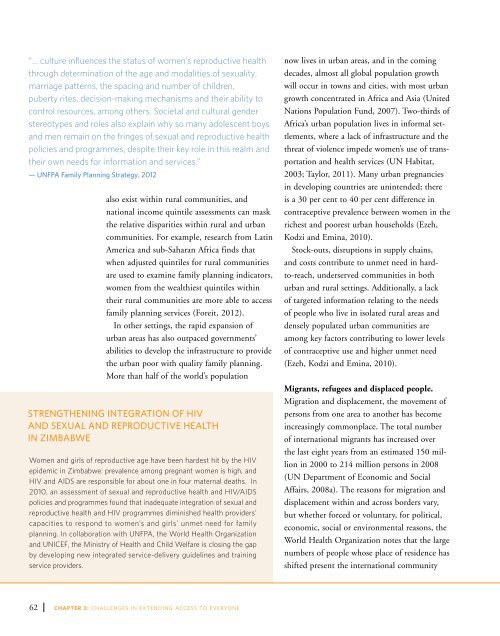State of World Population 2012 - Country Page List - UNFPA
State of World Population 2012 - Country Page List - UNFPA
State of World Population 2012 - Country Page List - UNFPA
You also want an ePaper? Increase the reach of your titles
YUMPU automatically turns print PDFs into web optimized ePapers that Google loves.
“… culture influences the status <strong>of</strong> women’s reproductive health<br />
through determination <strong>of</strong> the age and modalities <strong>of</strong> sexuality,<br />
marriage patterns, the spacing and number <strong>of</strong> children,<br />
puberty rites, decision-making mechanisms and their ability to<br />
control resources, among others. Societal and cultural gender<br />
stereotypes and roles also explain why so many adolescent boys<br />
and men remain on the fringes <strong>of</strong> sexual and reproductive health<br />
policies and programmes, despite their key role in this realm and<br />
their own needs for information and services.”<br />
— <strong>UNFPA</strong> Family Planning Strategy, <strong>2012</strong><br />
also exist within rural communities, and<br />
national income quintile assessments can mask<br />
the relative disparities within rural and urban<br />
communities. For example, research from Latin<br />
America and sub-Saharan Africa finds that<br />
when adjusted quintiles for rural communities<br />
are used to examine family planning indicators,<br />
women from the wealthiest quintiles within<br />
their rural communities are more able to access<br />
family planning services (Foreit, <strong>2012</strong>).<br />
In other settings, the rapid expansion <strong>of</strong><br />
urban areas has also outpaced governments’<br />
abilities to develop the infrastructure to provide<br />
the urban poor with quality family planning.<br />
More than half <strong>of</strong> the world’s population<br />
Strengthening integration <strong>of</strong> HIV<br />
and sexual and reproductive health<br />
in Zimbabwe<br />
Women and girls <strong>of</strong> reproductive age have been hardest hit by the HIV<br />
epidemic in Zimbabwe: prevalence among pregnant women is high, and<br />
HIV and AIDS are responsible for about one in four maternal deaths. In<br />
2010, an assessment <strong>of</strong> sexual and reproductive health and HIV/AIDS<br />
policies and programmes found that inadequate integration <strong>of</strong> sexual and<br />
reproductive health and HIV programmes diminished health providers’<br />
capacities to respond to women’s and girls’ unmet need for family<br />
planning. In collaboration with <strong>UNFPA</strong>, the <strong>World</strong> Health Organization<br />
and UNICEF, the Ministry <strong>of</strong> Health and Child Welfare is closing the gap<br />
by developing new integrated service-delivery guidelines and training<br />
service providers.<br />
now lives in urban areas, and in the coming<br />
decades, almost all global population growth<br />
will occur in towns and cities, with most urban<br />
growth concentrated in Africa and Asia (United<br />
Nations <strong>Population</strong> Fund, 2007). Two-thirds <strong>of</strong><br />
Africa’s urban population lives in informal settlements,<br />
where a lack <strong>of</strong> infrastructure and the<br />
threat <strong>of</strong> violence impede women’s use <strong>of</strong> transportation<br />
and health services (UN Habitat,<br />
2003; Taylor, 2011). Many urban pregnancies<br />
in developing countries are unintended; there<br />
is a 30 per cent to 40 per cent difference in<br />
contraceptive prevalence between women in the<br />
richest and poorest urban households (Ezeh,<br />
Kodzi and Emina, 2010).<br />
Stock-outs, disruptions in supply chains,<br />
and costs contribute to unmet need in hardto-reach,<br />
underserved communities in both<br />
urban and rural settings. Additionally, a lack<br />
<strong>of</strong> targeted information relating to the needs<br />
<strong>of</strong> people who live in isolated rural areas and<br />
densely populated urban communities are<br />
among key factors contributing to lower levels<br />
<strong>of</strong> contraceptive use and higher unmet need<br />
(Ezeh, Kodzi and Emina, 2010).<br />
Migrants, refugees and displaced people.<br />
Migration and displacement, the movement <strong>of</strong><br />
persons from one area to another has become<br />
increasingly commonplace. The total number<br />
<strong>of</strong> international migrants has increased over<br />
the last eight years from an estimated 150 million<br />
in 2000 to 214 million persons in 2008<br />
(UN Department <strong>of</strong> Economic and Social<br />
Affairs, 2008a). The reasons for migration and<br />
displacement within and across borders vary,<br />
but whether forced or voluntary, for political,<br />
economic, social or environmental reasons, the<br />
<strong>World</strong> Health Organization notes that the large<br />
numbers <strong>of</strong> people whose place <strong>of</strong> residence has<br />
shifted present the international community<br />
62 CHAPTER 3: CHALLENGES IN EXTENDING ACCESS TO EVERYONE
















